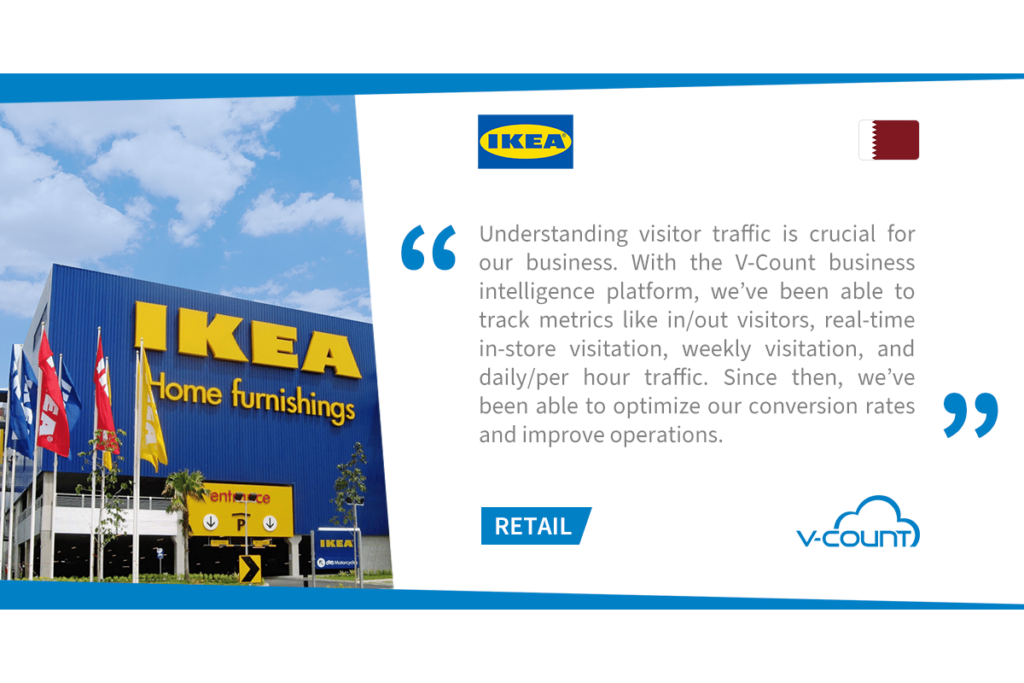In the retail and supermarket industry, effective people counting systems play a crucial role in understanding customer behavior, optimizing operations, and driving business success. Two key features that enhance the capabilities of these systems are queue management and staff exclusion.
Queue Management refers to the process of monitoring and controlling the flow of customers through checkout lines or service areas. By analyzing real-time data on queue lengths and wait times, businesses can make informed decisions to allocate resources effectively, reduce bottlenecks, and streamline the checkout process. This feature ensures that customers experience minimal wait times, leading to increased satisfaction and a better overall shopping experience.
Staff Exclusion is a feature that allows people counting systems to accurately differentiate between customers and employees. By excluding staff from the count, businesses can obtain precise data on customer traffic, enabling better decision-making and resource allocation. This feature is essential for gaining accurate insights into customer behavior, peak shopping times, and foot traffic patterns.
Both queue management and staff exclusion work in tandem to provide businesses with valuable data and tools to enhance operational efficiency, improve customer satisfaction, and ultimately drive better business outcomes.
Table of Contents
Importance of Queue Management

Effective queue management is a game-changer for businesses, particularly in the retail and supermarket sectors. By streamlining the flow of customers, it directly impacts crucial aspects like wait times, customer satisfaction, sales, and operational efficiency.
Reduced Wait Times: Long queues are a significant pain point for customers, often leading to frustration and a negative shopping experience. Implementing queue management strategies helps minimize wait times by ensuring an optimal number of open checkout lanes or service counters. This proactive approach prevents bottlenecks and keeps the lines moving smoothly, reducing the time customers spend waiting.
Increased Customer Satisfaction: Shorter wait times have a direct correlation with higher customer satisfaction levels. When customers don’t have to endure long queues, they perceive the overall shopping experience as more enjoyable and convenient. Satisfied customers are more likely to return, recommend the business to others, and develop brand loyalty, ultimately contributing to the success and growth of the establishment.
Higher Sales: Efficient queue management not only improves the customer experience but can also directly impact sales figures. When customers don’t face lengthy wait times, they are less likely to abandon their carts or make impulsive decisions to leave the store. Additionally, shorter queues create opportunities for impulse purchases near the checkout area, as customers have more time and patience to browse while waiting.
Operational Efficiency: Streamlined queues and optimized customer flow translate into improved operational efficiency. With effective queue management, businesses can better utilize their resources, such as staff and checkout lanes, reducing congestion and ensuring a smooth flow of customers throughout the store or premises. This efficient use of resources leads to cost savings and increased productivity, ultimately benefiting the bottom line.
Reduced Wait Times
Effective queue management plays a crucial role in minimizing customer wait times, leading to a significantly improved shopping experience. Long queues and extended wait times are among the most frustrating aspects of the retail environment, often resulting in customer dissatisfaction, abandoned purchases, and lost sales.
By implementing robust queue management strategies, businesses can streamline the flow of customers, ensuring that queues move efficiently and wait times are kept to a minimum. This can be achieved through a combination of techniques, such as optimizing checkout lane allocation, employing queue-busting strategies during peak hours, and leveraging advanced technologies like people counting systems.
When customers encounter shorter queues and faster service, their overall shopping experience is enhanced. They spend less time waiting in line and more time engaging with products and making purchases. This not only reduces frustration but also creates a positive association with the store, fostering customer loyalty and encouraging repeat visits.
Moreover, minimized wait times contribute to a more relaxed and enjoyable shopping atmosphere. Customers are less likely to feel rushed or stressed, allowing them to browse and make informed purchasing decisions without the pressure of a long line behind them. This relaxed environment can lead to increased dwell times and potentially higher sales as customers have more opportunities to discover additional products and make impulse purchases.
Increased Customer Satisfaction

Efficient queue management plays a crucial role in enhancing customer satisfaction by reducing wait times and providing faster service. Long queues and extended waiting periods are among the leading causes of customer frustration and dissatisfaction in retail and supermarket environments. By implementing effective queue management strategies, businesses can minimize these pain points and create a more positive shopping experience for their customers.
Research has consistently shown a direct correlation between shorter queues, faster service, and higher levels of customer satisfaction. When customers can navigate through the checkout process quickly and efficiently, they are more likely to feel valued and appreciated. This positive experience not only enhances their overall satisfaction but also fosters loyalty and encourages repeat visits.
Furthermore, shorter queues and faster service can alleviate the stress and anxiety often associated with prolonged waiting times. Customers are more likely to enjoy their shopping experience when they can complete their transactions smoothly, without the frustration of lengthy delays. This positive emotional state contributes to a more enjoyable overall experience, increasing the likelihood of customers recommending the business to others and leaving positive reviews.
By prioritizing queue management and ensuring efficient service, businesses can create a customer-centric environment that prioritizes convenience and satisfaction. This not only improves the overall shopping experience but also strengthens the brand’s reputation and fosters long-term customer loyalty, ultimately driving business success and growth.
Higher Sales
Efficient queue management plays a crucial role in boosting sales by promoting impulse purchases and reducing cart abandonment. When customers encounter long queues and extended wait times, their shopping experience is negatively impacted, leading to frustration and a higher likelihood of abandoning their purchases altogether.
However, with streamlined queues and minimal wait times, customers are more inclined to make additional impulse purchases while waiting to check out. The convenience of a smooth shopping experience encourages customers to browse and consider additional items, ultimately increasing the average transaction value.
Furthermore, shorter queues and faster service reduce the risk of customers abandoning their carts due to impatience or time constraints. Customers are more likely to complete their purchases when the checkout process is efficient and hassle-free, leading to higher conversion rates and increased sales for the business.
By implementing effective queue management strategies, retailers can create a pleasant shopping environment that encourages customers to spend more time browsing, make impulse purchases, and ultimately complete their transactions without the frustration of long wait times.
Operational Efficiency
Efficient queue management is crucial for maintaining a smooth flow of customers within a retail or supermarket environment. Long queues and congestion can create a chaotic atmosphere, leading to frustrated customers and a negative shopping experience. By implementing effective queue management strategies, businesses can streamline the movement of customers, reducing bottlenecks and ensuring a seamless shopping journey.
One of the primary benefits of streamlined queues is the reduction of congestion. When customers are able to move through checkout lines or service areas quickly, it prevents overcrowding and minimizes the risk of bottlenecks forming. This not only enhances the overall shopping experience but also improves safety by reducing the likelihood of accidents or incidents caused by overcrowding.
Additionally, efficient queue management allows for better utilization of available space within the store or supermarket. Instead of having customers clustered in specific areas, leading to congestion, a well-managed queue system can distribute customers evenly throughout the facility. This not only creates a more organized and inviting environment but also ensures that customers can navigate the store with ease, potentially increasing impulse purchases and overall sales.
Moreover, streamlined queues contribute to improved staff productivity and efficiency. When employees are not overwhelmed by long lines and congestion, they can focus on providing better service to customers, leading to faster transaction times and a more positive overall experience. This, in turn, can enhance employee morale and job satisfaction, ultimately contributing to a more productive and engaged workforce.
By implementing effective queue management strategies, businesses can optimize the flow of customers, reduce congestion, and create a more organized and efficient shopping environment. This not only enhances the overall customer experience but also contributes to improved operational efficiency, increased sales, and a more productive workforce.
Importance of Staff Exclusion

Ensuring accurate customer data is crucial for effective decision-making in retail and supermarket operations. One of the key features that contributes to this is staff exclusion in people counting systems. By excluding staff members from the count, businesses can obtain precise insights into customer traffic patterns, enabling them to make informed decisions and optimize their operations.
Accurate customer data is the foundation for optimized staffing. With a clear understanding of peak hours and customer flow, businesses can schedule the right number of employees at the right times. This not only enhances customer service but also reduces labor costs by avoiding overstaffing during slow periods.
Precise foot traffic data also plays a pivotal role in resource management. By analyzing customer traffic patterns, businesses can better plan their inventory levels, ensuring they have sufficient stock to meet demand while minimizing excess inventory. This leads to improved inventory turnover, reduced waste, and increased profitability.
Moreover, staff exclusion in people counting systems provides businesses with improved insights into customer behavior. By separating staff from customer data, businesses can gain a deeper understanding of how customers navigate their stores, identify bottlenecks, and optimize store layouts for a smoother shopping experience. These insights can inform strategic decisions related to product placement, promotional campaigns, and store design.
Overall, staff exclusion is a critical feature in people counting systems, enabling businesses to obtain accurate customer data, optimize staffing levels, manage resources efficiently, and gain valuable insights into customer behavior. By leveraging these benefits, retail and supermarket operations can enhance their overall performance, customer satisfaction, and profitability.
Accuracy in Data
Accurate customer data is the foundation for informed decision-making in any retail or supermarket business. People counting systems that fail to exclude staff from their data collection can skew the numbers, leading to flawed insights and misguided strategies. By implementing staff exclusion, businesses can ensure that their people counting data reflects genuine customer traffic, enabling them to make data-driven decisions with confidence.
When staff members are inadvertently counted as customers, it can distort the true picture of foot traffic patterns, peak hours, and customer behavior. This inaccurate data can lead to inefficient resource allocation, understaffing during busy periods, and overstaffing during slower times, ultimately impacting operational efficiency and customer satisfaction.
By accurately separating staff from customer data, retailers and supermarkets can gain a precise understanding of their customer flow. This knowledge empowers them to optimize staffing levels, ensuring the right number of employees are available to provide prompt service during peak hours, while avoiding overstaffing during slower periods, resulting in cost savings.
Moreover, accurate customer data is essential for making informed decisions about marketing campaigns, product assortments, store layouts, and other strategic initiatives. With a clear picture of customer traffic patterns, businesses can tailor their offerings, promotions, and in-store experiences to better meet the needs and preferences of their target audience, ultimately driving customer satisfaction and loyalty.
Optimized Staffing

Accurate foot traffic data obtained through effective staff exclusion is a game-changer for optimizing staffing levels in retail stores and supermarkets. By precisely counting the number of customers entering and exiting the premises, businesses can gain valuable insights into peak shopping hours and adjust their workforce accordingly.
With a clear understanding of when customer influx is at its highest, managers can schedule the right number of employees to handle the increased demand. This proactive approach ensures that there are sufficient staff members available to provide prompt service, reducing wait times and enhancing the overall customer experience.
Moreover, by avoiding overstaffing during slower periods, businesses can optimize their labor costs and allocate resources more efficiently. Accurate data empowers managers to make informed decisions about staffing levels, striking the perfect balance between providing excellent customer service and maintaining operational efficiency.
By leveraging people counting systems with staff exclusion capabilities, businesses can effectively match their staffing levels to the ebbs and flows of customer traffic, ensuring a seamless shopping experience and maximizing productivity.
Resource Management
Effective resource planning and inventory management are crucial for any retail or supermarket business. Accurate foot traffic data, obtained through people counting systems with staff exclusion, plays a pivotal role in optimizing these processes. By precisely tracking customer flow, businesses can align their resources with actual demand, minimizing waste and maximizing efficiency.
When it comes to inventory management, having a clear understanding of customer traffic patterns is invaluable. With accurate data on peak shopping times and customer volumes, businesses can make informed decisions about stock levels, ensuring they have the right products available in the right quantities at the right times. This not only reduces the risk of overstocking or understocking but also helps to minimize inventory carrying costs and potential losses due to spoilage or obsolescence.
Moreover, precise foot traffic data enables businesses to optimize their staffing levels and scheduling. By analyzing customer traffic patterns, managers can identify peak periods and allocate the appropriate number of employees to handle the increased demand effectively. This not only enhances customer service but also contributes to cost savings by avoiding overstaffing during slower periods.
Furthermore, accurate foot traffic data can aid in the efficient allocation of other resources, such as checkout counters, fitting rooms, and even parking spaces. By understanding customer flow patterns, businesses can strategically position these resources to maximize their utilization and enhance the overall shopping experience for customers.
In summary, by leveraging accurate foot traffic data obtained through people counting systems with staff exclusion, retail and supermarket businesses can streamline their resource planning and inventory management processes. This leads to reduced waste, improved efficiency, and ultimately, a more profitable and sustainable operation.
Improved Insights
Accurate people counting data, made possible by effectively excluding staff from the count, provides invaluable insights into customer behavior and peak shopping times. These insights are crucial for businesses to make informed strategic decisions that can drive growth and improve operations.
By analyzing precise foot traffic data, businesses can identify patterns in customer behavior, such as preferred shopping hours, popular product displays, and high-traffic areas within the store. This knowledge enables retailers to optimize their operations accordingly, ensuring that they have the right staffing levels, inventory levels, and promotional strategies in place during peak times.
Moreover, accurate data on customer behavior can reveal valuable information about customer preferences and buying habits. This information can be used to tailor product offerings, merchandising strategies, and marketing campaigns to better align with customer needs and desires, ultimately leading to increased customer satisfaction and loyalty.
Furthermore, by understanding peak shopping times, businesses can effectively manage their resources, such as staff scheduling, inventory management, and energy consumption. This not only improves operational efficiency but also contributes to cost savings and environmental sustainability.
Overall, the precise data provided by effective staff exclusion in people counting systems empowers businesses with the insights they need to make data-driven decisions that drive growth, enhance customer experiences, and optimize operations, giving them a competitive edge in today’s dynamic marketplace.
Real-World Applications

Queue management and staff exclusion have proven to be game-changers for many businesses across various industries. One notable example is a renowned supermarket chain that implemented V-Count’s people counting solution with these features. Prior to the implementation, the supermarket faced challenges with long queues during peak hours, leading to customer dissatisfaction and potential loss of sales.
After integrating queue management, the supermarket was able to monitor and manage queues effectively. By deploying additional staff during high-traffic periods, they significantly reduced wait times, resulting in a 25% increase in customer satisfaction scores. Moreover, the streamlined queues encouraged impulse purchases, contributing to a remarkable 8% boost in sales.
Another success story comes from a popular retail clothing store that struggled with accurate staffing and inventory management. By leveraging staff exclusion, the store gained precise insights into customer traffic patterns, enabling them to optimize staff scheduling and inventory levels. This data-driven approach led to a 15% reduction in labor costs and a 20% decrease in stockouts, enhancing the overall shopping experience for customers.
These real-world examples demonstrate the tangible benefits of integrating queue management and staff exclusion into people counting systems. By leveraging accurate data and streamlining operations, businesses can achieve higher customer satisfaction, increased sales, and improved operational efficiency, ultimately driving better overall performance.
Conclusion
In today’s competitive retail landscape, delivering an exceptional customer experience is paramount to success. Queue management and staff exclusion features in people counting systems are invaluable tools that can significantly enhance operational efficiency, customer satisfaction, and overall business performance.
By implementing effective queue management strategies, businesses can minimize customer wait times, reduce frustration, and foster a more enjoyable shopping experience. This not only leads to increased customer satisfaction but also drives higher sales and impulse purchases, as customers are more likely to make additional purchases when they don’t have to endure long queues.
Moreover, accurate staff exclusion ensures that people counting data reflects actual customer traffic, providing invaluable insights into peak shopping times, customer behavior, and staffing requirements. This precise data empowers businesses to optimize staffing levels, manage resources effectively, and make informed decisions that drive operational excellence.
The benefits of integrating queue management and staff exclusion in people counting systems are undeniable. Real-world examples and case studies have demonstrated significant improvements in customer satisfaction, sales, and operational efficiency for businesses that have embraced these solutions.
To stay ahead of the competition and deliver a truly exceptional customer experience, we encourage you to explore V-Count’s cutting-edge solutions for effective queue management and staff exclusion. By leveraging these powerful features, you can unlock a world of opportunities and drive your business to new heights of success.







